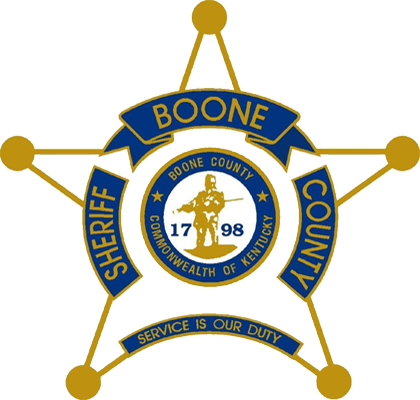TRAFFIC CALMING PROCEDURES
The Traffic Safety Committee (TSC) is comprised of representatives from the Boone County Sheriff’s Office, Boone County Public Works Department, Boone County Planning & Zoning and members of the Boone County Fiscal Court, Judge-Executive’s Office. Combined, each group serves as a partnership with one another to consider the following actions and if changes to a location may be deemed necessary. Each group can recommend changes or changes may be considered after a complaint is made by someone living in the community.
STEP I – OBSERVATION AND EVALUATION
- Upon receipt of initial traffic request, the Boone County Sheriff’s Office will work in conjunction with Boone County Public Works to investigate the complaint. Deputies will observe the reported area and Public Works will ensure that signage and road markings are in compliance with the Manual on Uniform Traffic Control Devices (MUTCD) standards. If the investigation reveals an immediate safety concern, the Sheriff’s Office and Public Works will work to provide a temporary solution to the issue.
- Findings from both departments will be presented to the Traffic Safety Committee. If speed and traffic volume are considered to be egregious or present on-going safety issues, approval to move forward to Step II will be granted.
STEP II – SPEED STUDY AND ENFORCEMENT
- Speed Study: The Engineering Services Division within Public Works will initiate a speed study to determine the extent of the speed and/or volume problem. Data will be collected over the course of one week’s time. Crash data history will also be studied in conjunction with the speed study findings.
- Sheriff Radar Signs: After the speed study data has been reviewed and, if deemed necessary by the Traffic Safety Committee, Sheriff’s Radar Signs may be placed throughout the area in question by the Sheriff’s Office for a period of time. A second speed study will be initiated after implementing the use of radar signs in order to measure any changes.
- Traffic Enforcement: In instances where the results from the second speed study indicate a continued speed issue or in instances where the totality of the information necessitates, deputies will perform enhanced traffic enforcement. The period of time traffic enforcement will be utilized will be at the Sheriff’s Office’s discretion. A follow-up speed study can be conducted if the residents and/or the Traffic Safety Committee feel the problem is continuing, even with heightened enforcement.
STEP III – SIGNAGE/ TRAFFIC DESIGN
Signage and traffic design elements may be considered by the Traffic Safety Committee if the changes in Step II do not resolve the residents’ concerns. The step(s) appropriate in a given situation shall be determined by the Traffic Safety Committee. These next steps are based upon a review of the issue and all available information/data associated with it. Additional speed studies will be gathered for comparison at any time during this phase as changes are introduced. Options include:
- Addition/removal/change of signage
- Parking restrictions in identified areas
- Changes to permitted speeds
- Alterations to traffic flow
STEP IV – PHYSICAL ROAD STRUCTURES
Physical road structures can be considered by the Traffic Safety Committee if the changes in Step II and/or III do not resolve the residents’ concerns. The designs of these structures are built based on standards set forth by the Federal Highway Administration (FHWA). The structure(s) appropriate in a given situation shall be determined by the Traffic Safety Committee. Determining the appropriate structures will be based upon a review of the complaint in addition to all the available information/data associated with it. Additional speed studies will be gathered for comparison at any time during this phase as changes are introduced. Options for physical road structures include:
- Raise Pavement Markings and/or Thermo Markings: Raised pavement markers and thermo markings may be implemented to supplement standard pavement markings if a higher degree of visibility is warranted.
- Rumble Strips: Rumble strips are a set of grooves along the edge of a roadway or across a road that cause noise and shaking when they are driven over. Rumble strips are used to warn drivers that they need to slow down or are too close to the edge of the road.
- Speed Humps: A speed hump is a raised area on the roadway pavement surface extending transversely across the travel way. Speed humps are constructed with a height of 3 to 4 inches and a travel length of 12 to 14 feet. Within typical residential operational speed ranges, vehicles slow to about 15 mph on streets with properly spaced speed humps.
- Speed Tables: Speed tables are generally constructed with a height of 3 to 3.5 inches and a travel length of 22 feet. Speed tables generally consist of 10 foot plateau with 6 foot approaches on either side that can be straight, parabolic or sinusoidal in profile. The longer lengths of speed tables provide a more gentle ride than speed humps. Speed tables generally result in vehicle operating speeds that range from 25 to 30 MPH on streets, depending on the spacing between each speed table.
LIMITATION ON REINTRODUCTION OF REQUEST
Once a request has gone through the traffic process it is considered closed, regardless of outcome. The same request, or its counterpart, cannot be presented for reconsideration for a period of at least one year, unless the Traffic Safety Committee determines that specific conditions or events have changed from the point it was originally examined.
